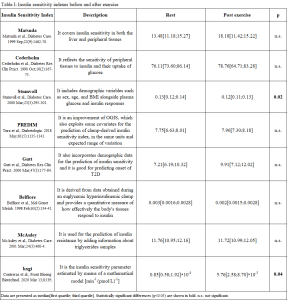Background and aims: Exercise offers several health benefits, particularly for metabolic and cardiovascular health, also due to its ability to act on insulin sensitivity. Different methods are available to estimate insulin sensitivity/resistance, encompassing both direct and indirect measures and using fasting glucose and insulin concentrations as well as glucose challenge tests. For the latter case, empirical indexes or mathematical modeling approaches are available. This study aimed to compare the ability of different methods for insulin sensitivity quantification to detect differences before and after an exercise bout. Methods: The study utilized an openly available dataset including data from ten healthy men (age: 23±3 years; BMI: 23.3±1.8 kg/m2; VO2 peak: 52.7±8.9 ml/kg per min), who underwent a 2-hour oral glucose tolerance test (OGTT) both before and after completing a 60-minute cycling exercise session on an ergometer set at 50% of maximal power output. During the test, plasma glucose (mmol/L) and insulin samples (pmol/L) were collected every 15 minutes (except for the samples at 75 and 105 minutes) resulting in a protocol of seven samples. A total of eight methods were used to assess insulin sensitivity, namely Matsuda, Cederholm, Stumvoll, PREDIM, Gutt, Belfiore, McAuley (data-driven indexes), and kxgi index derived by Contreras, the latter requiring a mathematical modeling approach. Statistical differences between pre- and post-exercise values were evaluated, as well as correlations among the computed index variations. Results: Indexes before and after exercises are reported in Table I. Two out of eight indexes showed significant differences between rest and post-exercise conditions. A strong significant correlation was observed between Stumvoll and kxgi (ρ=0.83, p=0.005), Matsuda and Belfiore (ρ=0.86, p=0.003), PREDIM and Gutt (ρ=0.88, p=0.001), and Cederholm and Belfiore (ρ=0.94, p=<0.0001). Conclusions: Different indexes for quantification of insulin sensitivity may provide different information since not all of them are able to detect differences before and after an exercise bout.


